Introduction
The transition to cloud-based solutions represents a pivotal moment for organizations seeking to enhance operational efficiency and drive innovation. However, the journey toward successful cloud migration is fraught with complexities that demand careful planning and execution.
A clear cloud migration strategy serves as an essential roadmap, guiding organizations through the multifaceted landscape of technological change. From assessing existing infrastructures to establishing robust security measures, the intricacies of this process require a comprehensive understanding of both the opportunities and challenges presented by cloud technology.
As organizations navigate this transformative journey, they must prioritize:
- Strategic planning
- Risk management
- Talent development
to ensure a seamless and effective migration that aligns with their overarching business goals.
The Importance of a Clear Cloud Migration Strategy
A well-defined cloud transition strategy acts as a roadmap for organizations aiming to move to cloud-based solutions successfully. This strategy must start with a meticulous evaluation of existing infrastructure, applications, and data, as these assessments serve as the foundation for informed decision-making during the transition. It is crucial to establish clear objectives for the migration, along with a detailed plan that specifies timelines, resource allocation, and addresses cloud migration risks and mitigation measures.
Without such preparation, entities may encounter substantial disruptions due to cloud migration risks and mitigation, obstructing their capacity to align digital initiatives with overarching business objectives. Key elements to consider in this process include:
- Stakeholder engagement to ensure buy-in
- Effective change management to facilitate smooth transitions
- Ongoing evaluation of the strategy in relation to evolving business needs
As Cody Slingerland aptly notes, 'Combined, these two regions account for 82% of the world’s computing,' highlighting the necessity for organizations to stay informed about regional trends and practices in technology.
This regional dominance is clear, as the U.S. and Western Europe represent 82% of the global computing market, influencing global trends and practices in technology. Additionally, with 82% of decision-makers identifying the management of spending as their top concern, having a comprehensive strategy becomes even more critical for optimizing expenditures and maximizing business performance. Additionally, with Alibaba Cloud achieving a 4% market share in 2023, companies must stay cognizant of market dynamics and rivalry in digital services to ensure their strategies are both effective and competitive.
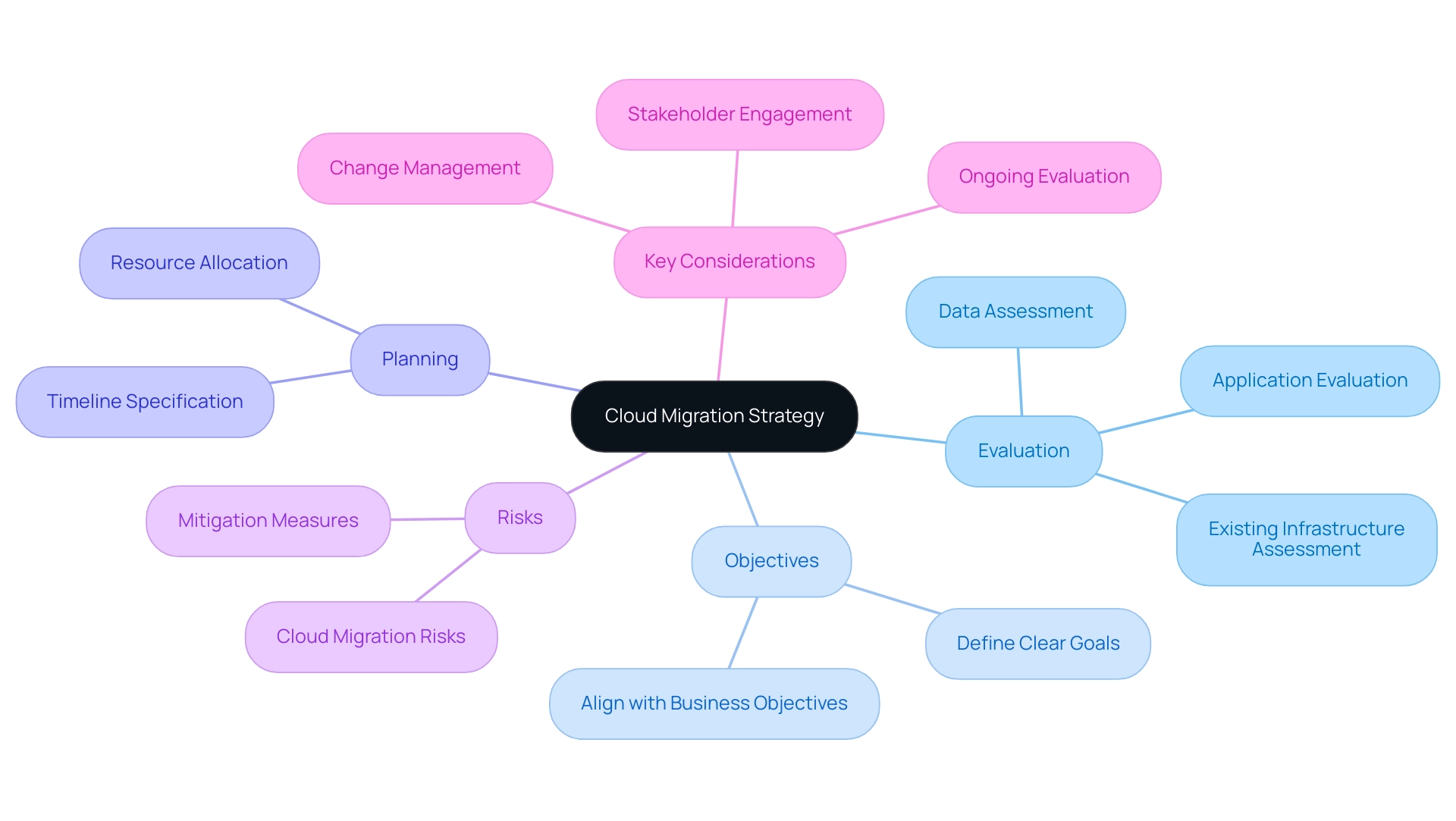
Navigating Data Security Risks in Cloud Migration
Cloud migration risks and mitigation during online migration present significant challenges, manifesting in threats such as data loss, unauthorized access, and compliance violations. A staggering 52% of organizations recognize insecure interfaces in public digital environments as a critical risk, underscoring the necessity for a comprehensive evaluation of cloud migration risks and mitigation to pinpoint and address these vulnerabilities. Significantly, Amazon Web Services (AWS) holds 31% of the cloud infrastructure services market, emphasizing the necessity of addressing implications in a landscape led by a few major players.
To address cloud migration risks and mitigation, essential protective measures include:
- The encryption of sensitive data
- The implementation of robust access controls
- Strict adherence to relevant regulations like GDPR and HIPAA
Furthermore, implementing a multi-cloud approach can help in understanding cloud migration risks and mitigation by diversifying risk exposure, which improves overall data protection. Organizations also need to prioritize regular audits and continuous monitoring of their digital environments to effectively manage cloud migration risks and mitigation, allowing for the proactive detection and response to threats.
As Cody Slingerland aptly notes, > Combined, these two regions account for 82% of the world’s computing <, highlighting the global reliance on such services and the accompanying responsibility to safeguard data effectively. Furthermore, a recent case study shows that 56% of IT decision-makers do not comprehend their cloud provider’s plans for AI integration, indicating a critical lack of clarity that can affect protective measures. In light of recent reports indicating that by 2025, IT could contribute to 8% of global GHG emissions, addressing data security risks is not just a technical imperative but also a crucial component of corporate environmental responsibility.
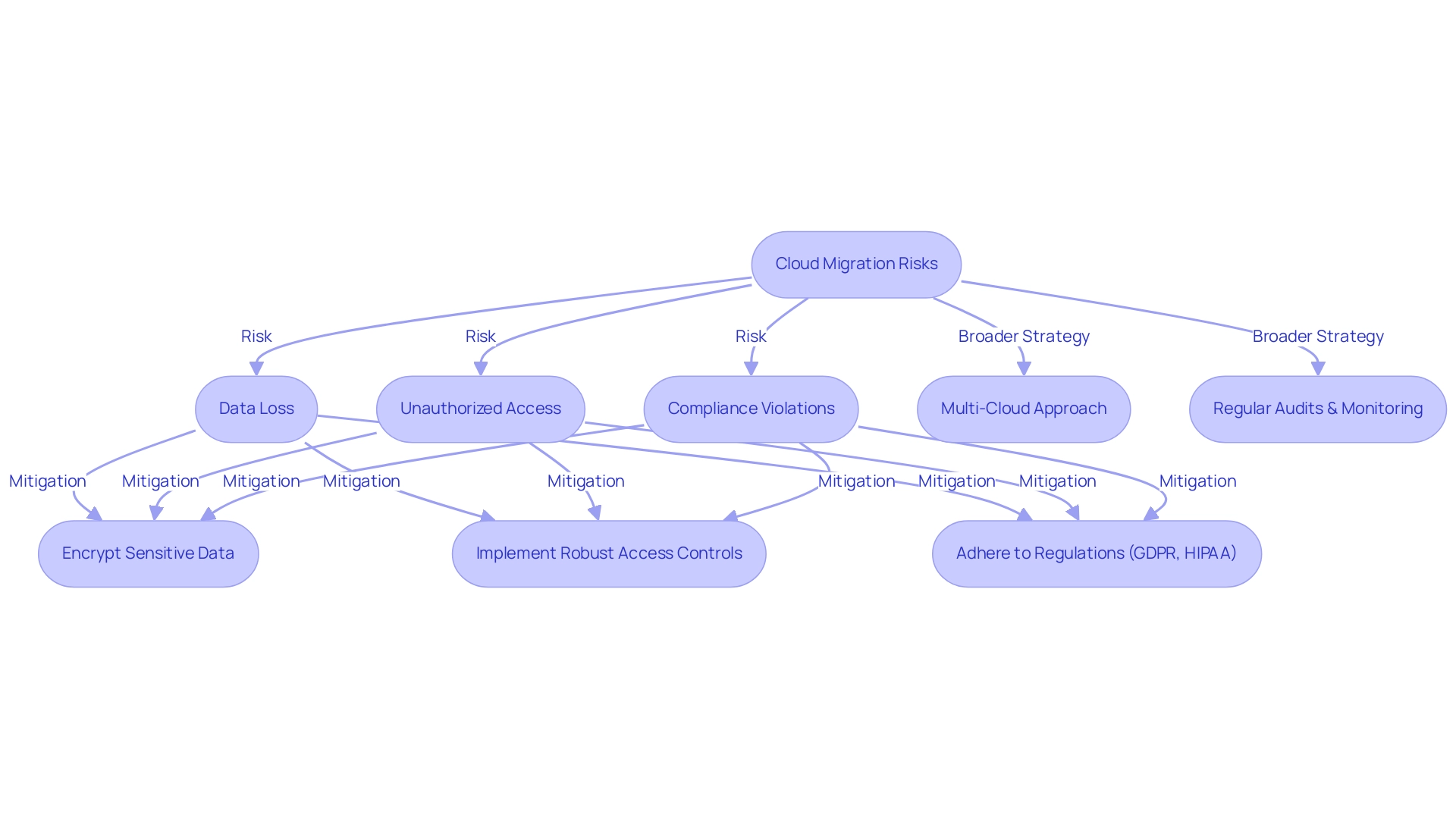
Understanding Cost Overruns and Financial Risks
Cloud transition often leads to unexpected expenses that surpass initial projections, commonly referred to as cost overruns. A recent prediction from Gartner highlights that by 2024, 60% of infrastructure and operations leaders will encounter public cloud cost overruns that negatively impact their on-premises budgets. These overruns can stem from several factors, including:
- The underestimation of resources required for migration
- The need for additional staff training
- Unforeseen costs related to data transfer and storage
Significantly, companies are 57 percent more likely to hire for advanced skill sets such as DevOps and FinOps, emphasizing the importance of skilled personnel in managing these transitions. To effectively address cloud migration risks and mitigation, entities must construct a detailed budget that encompasses all potential expenses and incorporates a buffer for unexpected costs. Regular financial reviews throughout the transition process are crucial, allowing organizations to remain aligned with their budgetary goals and make necessary adjustments as circumstances evolve.
Furthermore, shifting high-performance workloads to remote servers can accelerate product development and time to market, allowing businesses to innovate rapidly. A practical illustration of this approach can be seen in Onix's case study, where a structured methodology was employed to assess existing infrastructure, ensuring a smoother transition and managing transfer expenses. By utilizing tools such as:
- Eagle for assessment
- Raven for code transformation
- Pelican for validation
Onix successfully addressed cloud migration risks and mitigation related to the financial risks typically associated with transitioning to a virtual environment, thereby enhancing overall project efficiency.
For additional insights, companies can download the available eBook on reducing cost overruns in data migration.
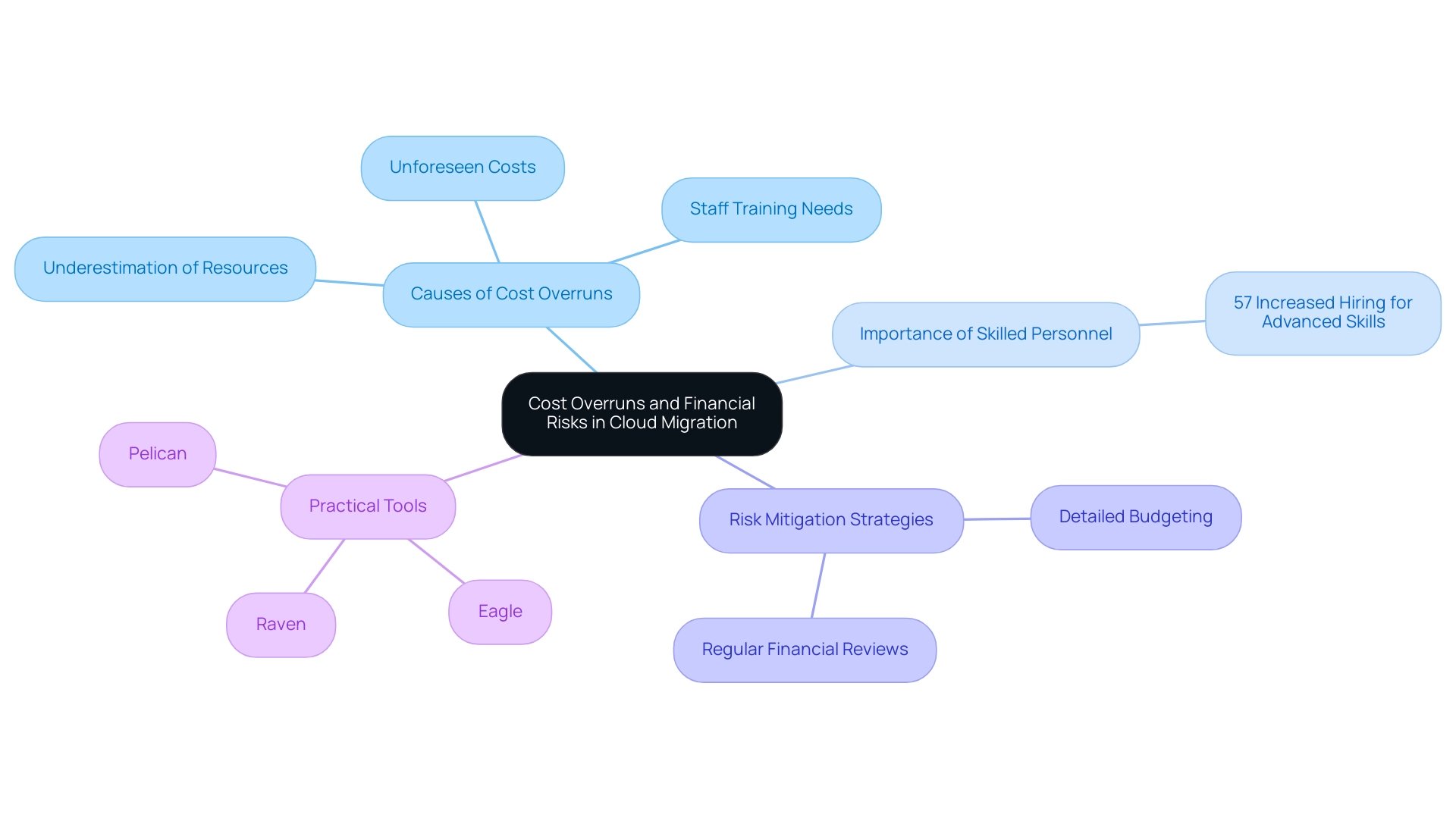
Mitigating Vendor Lock-In Risks
Vendor lock-in is a critical concern for entities that become excessively reliant on a single cloud provider, leading to challenges when attempting to switch vendors or migrate to alternative platforms. This reliance can lead to significant expenses, with a Professional Account for teams of up to 5 individuals costing $959 USD per month, which can increase if entities are bound by unfavorable contracts. Additionally, operational disruptions can arise from vendor lock-in.
To effectively mitigate cloud migration risks and mitigation, entities are encouraged to adopt a multi-cloud strategy, which involves leveraging services from various providers to foster flexibility and resilience. According to industry insights, 2024 is expected to see a significant rise in the adoption of multi-cloud strategies, as organizations recognize the importance of avoiding vendor lock-in. Furthermore, the risks related to vendor lock-in are highlighted by the compromise of AMD's secure VM technology through a BadRAM attack, underscoring the need for robust Identity and Access Management (IAM) solutions.
Negotiating contracts that ensure the portability of data and applications is essential to mitigate cloud migration risks and facilitate transitions when necessary. Employing open-source technologies and adhering to standardized APIs can further streamline the migration process, thereby reducing the cloud migration risks and mitigation associated with lock-in. Significantly, leading IAM solutions, such as Okta, AWS IAM, and Azure Active Directory, play a crucial role in enhancing security and compliance across online services, thereby assisting organizations in navigating these complexities.
As Cody Slingerland observes, the combined market dominance of two major regions represents 82% of the global computing infrastructure, emphasizing the significance of strategic partnerships to sustain a competitive advantage in this changing environment.
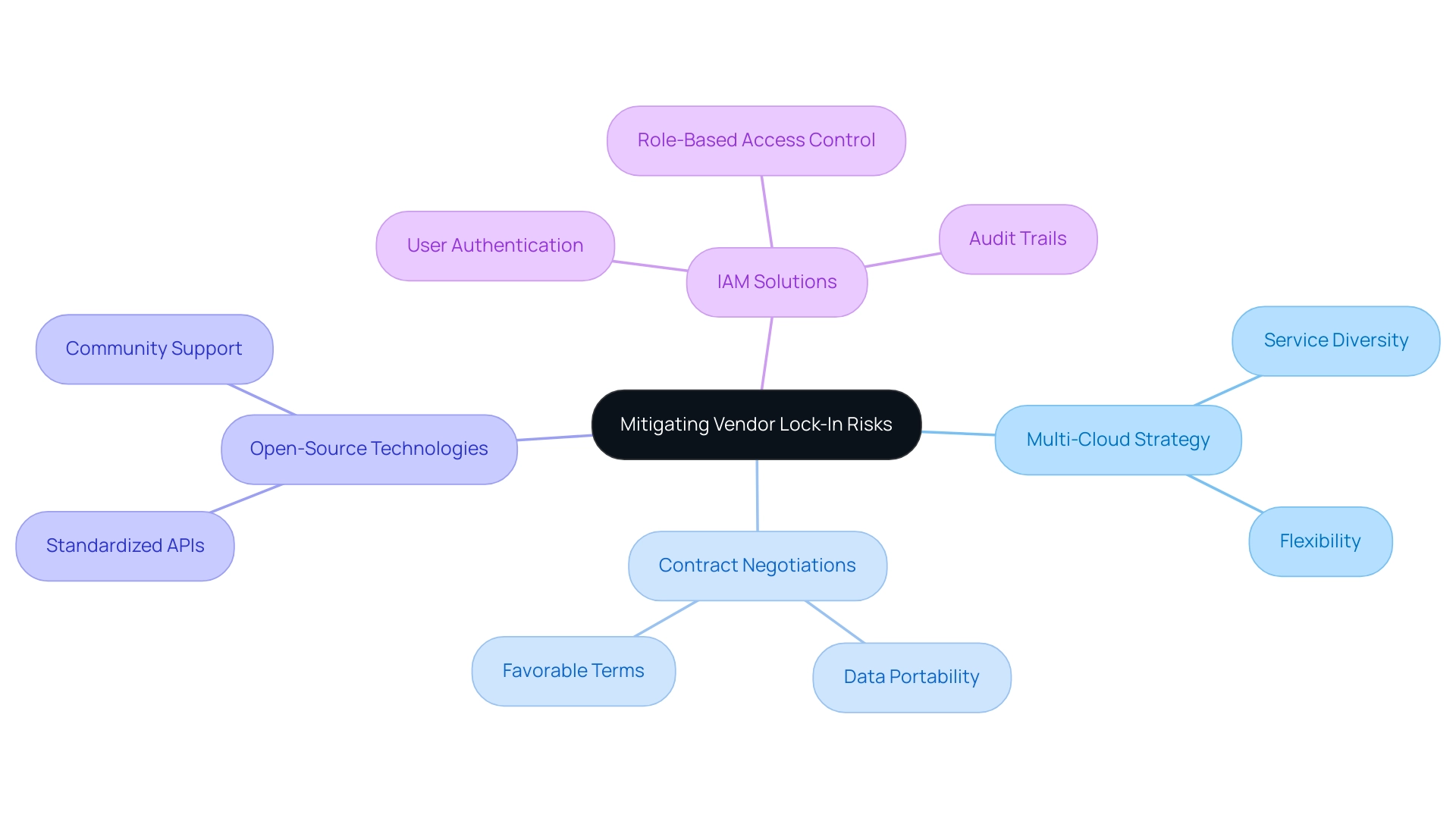
Bridging the Skill Gap in Cloud Migration
Navigating the complexities of transitioning to digital storage requires a workforce that is not only skilled but also proficient in the latest technologies and best practices. Recent statistics reveal an alarming trend: the workforce gap in this domain has surged by 19% year-on-year, reaching 4.8 million skilled positions left unfilled. This shortfall can severely impede efforts to address cloud migration risks and mitigation, often resulting in significant delays and escalated costs.
To tackle this challenge, companies must emphasize funding in training initiatives focused on enhancing the skills of current staff while also drawing in new talent skilled in technology. Collaborations with educational institutions and structured internship programs can further enhance the talent pipeline, ensuring a steady influx of skilled professionals. Moreover, cultivating a culture of ongoing education is essential; enterprises should encourage their staff to stay updated on the latest developments in computing technologies.
This proactive approach not only equips teams with necessary skills but also positions the organization favorably within an increasingly competitive digital landscape. As highlighted by industry leaders, aligning professional development efforts with existing skill gaps is essential for promoting organizational growth and achieving successful transitions. Furthermore, as emphasized during FINSEC2022, tackling privacy issues in transitioning to digital services is vital, stressing that the CFO's role in transforming enterprise compliance is crucial for managing these challenges.
Moreover, Jason Soroko from Sectigo discussed the importance of assessing current security frameworks and identifying integration points for new technologies, which is vital for organizations looking to address cloud migration risks and mitigation while bridging the skill gap.
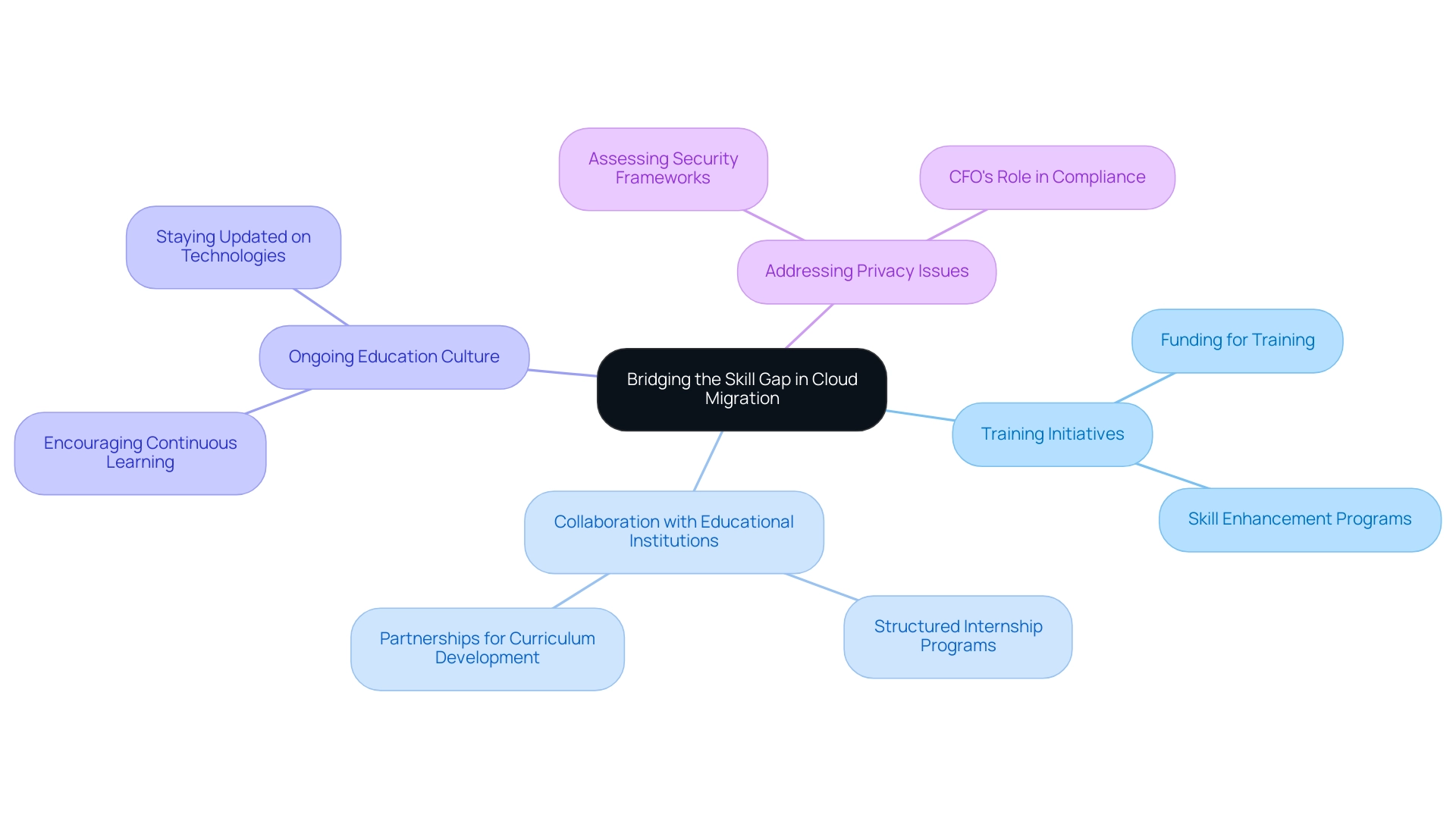
Conclusion
Successfully transitioning to cloud-based solutions is a multifaceted endeavor that requires a well-defined migration strategy. This strategy must encompass:
- A thorough assessment of existing infrastructures
- Clear objectives
- A detailed plan that includes:
- Timelines
- Resource allocation
- Risk management measures
By engaging stakeholders and implementing effective change management practices, organizations can navigate the complexities of cloud migration while aligning their initiatives with broader business goals.
Data security remains a paramount concern throughout this process, with organizations facing risks such as data loss and compliance violations. A comprehensive risk assessment, bolstered by robust security measures and continuous monitoring, is essential for safeguarding sensitive information in a cloud environment. Moreover, addressing the financial implications of cloud migration, including potential cost overruns, requires careful budgeting and regular financial reviews to stay aligned with organizational goals.
To mitigate vendor lock-in risks, adopting a multi-cloud strategy is advisable, allowing organizations to maintain flexibility and resilience in their cloud operations. This approach not only enhances security but also supports effective management of cloud services across various providers. Additionally, bridging the skill gap through targeted training and continuous learning initiatives will empower teams to successfully navigate the complexities of cloud migration.
In conclusion, the journey to cloud migration is fraught with challenges, but with strategic planning, risk management, and talent development at the forefront, organizations can leverage the full potential of cloud technology. Embracing these principles will not only facilitate a seamless transition but will also position organizations to thrive in an increasingly competitive digital landscape.




